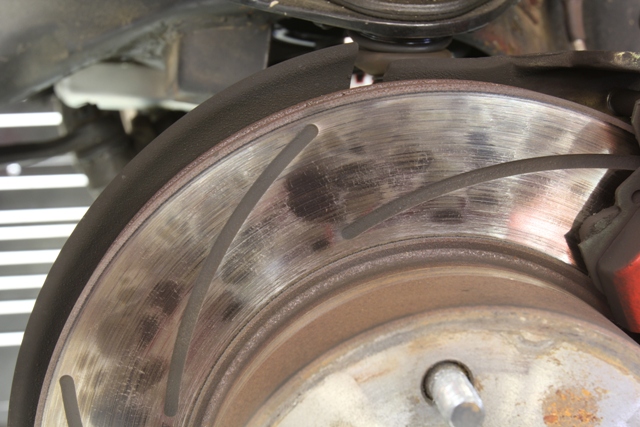
The bluish hot spots on this rotor likely caused by inconsistent transfer of material between the pad the rotor. These were probably created when the pads were not properly bed in. You might be able to see this rotor is also suffering from surface stress cracks. This rotor should be replaced.
I’m thinking of upgrading the front disc brakes on my ’69 Chevelle with better pads. The car is a 454 with a Turbo 400 and stock front disc rotors and calipers and runs in the low 12’s at 110 mph. I want to get it stopped quicker but I can’t afford those expensive 14-inch rotor disc brake systems. Do you have any recommendations for pads that would work? Also, I’ve read that I should do some kind of break-in before I go out and hammer these new pads. Do you know what they’re talking about?
J.A., El Cajon, CA
This is a great topic because there’s a ton of misinformation about brake pads and procedures, so let’s get started. There is also a huge range of product quality when it comes to brake pads. The great thing about your Chevelle is that it uses what is called the D52 pad, which is a very common brake pad. This means you have a very broad spectrum of choices that range from stock replacement pads literally for $10.97 per set all the way up to some high quality race pads that can cost over $150 per set. Because you mentioned you’d like to improve stopping distance at 100-plus miles per hour, a quality brake pad will really help.
We found an excellent paper on Stop Tech’s website that discusses all of the information that we’ll detail here and there’s more than we can really get into in this short answer. The first thing to know is that brakes work by converting kinetic energy (a moving car) into heat energy. Brake pads do this by using two methods – abrasive friction and adherent friction. The abrasive friction is best illustrated by the older versions of semi-metallic brakes that worked well but absolutely destroyed the rotors in a very short time. Most modern brake pads use both forms friction to perform their duties. Adherent is where the brake pad actually transfers pad material from the pad to the rotor. Once this transfer is completed, there is a much higher coefficient of friction created between the pad and the rotor. This drastically improves the coefficient of friction between the pad and the rotor while not necessarily wearing the rotor. But this transfer of material must be initially accomplished properly for the brake pads to perform at their peak efficiency. This is why new brake pads must be bedded in. This procedure is directly related to the style of brake pad that you are using. We can put these pads into two basic categories of street pads and race pads. The main difference between the two is the operating temperature range intended for the pads. Street pads generally operate somewhere between 100 and 600 degrees F while race pads push that temperature up to between 600 and 1,400 degrees F.
OnAllCylinders has already gone into some detail in terms of how to bed-in your brakes so we won’t get into that here. You can read that story here.
While you can easily swap pads onto your existing rotors, the best procedure is to use new rotors, especially if your existing rotors have hot spots. Hot spots are those bluish areas on the rotor that most people think are produced by a warped rotor. The truth is these spots are usually caused by inconsistent material transfer between the pad and the rotor. This inconsistency creates a high spot, which turns into a hot spot that becomes so hard that it cannot be machined. When that happens, the only real solution is to replace the rotors.
You also asked about pad recommendations and we’ve come up with several that can be found on the Summit Racing website. Because your car is used for drag racing, the brakes are almost always cold so a street pad that has good cold brake torque characteristics is the best pad to use. Among these are EBC’s Green Stuff pads, a Hawk, Baer’s Sport pad or StopTech’s Street pad. All of these pads will exhibit slightly different brake torque characteristics but any of these will do a better job than stock replacement pads. Consider also that while upgrading to a larger aftermarket disc brake rotor and caliper system is not a bad idea, getting the car to stop in the shortest distance possible still comes down to the contact patch between the tire and the road. “Pizza cutter” front tires with their small contact patch only make stopping the car that much more difficult. Often too, a tire that is six years old or older has probably become hard, especially on the west coast where ozone issues tend to accelerate this drying out process. You might want to consider stepping up to a better tire to improve braking performance.

Please help!! I was given a set of brake pads and want to know if they will work on my vehicle. I would be grateful for any help!! Thank-you very much, Ms. Tracy Schoolcraft
If you give me the pertinent information on the car as well as the PN for the brake pads and the manufacturer then I can look into it for you.
Did you want to help me figure this out? 1997 Chevy S10 blazer,it has both 4WD and regular drive (is that AWD?) Engine size- 4.3 liter, 6 cyl, fuel injection- vortex. The brake pads I received have an SKU # 5520800 please email me at your earliest convience. Thank -you Tracy Schoolcraft